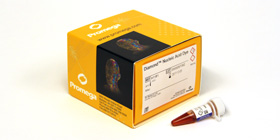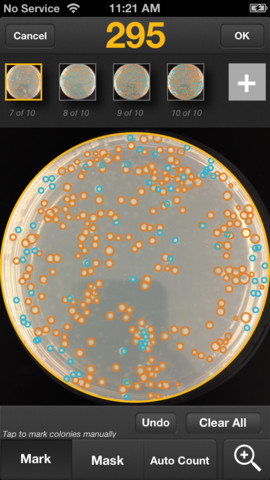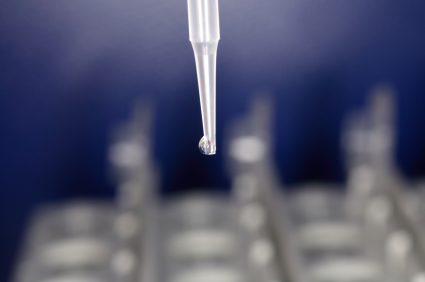It’s a scientist’s nightmare: Spending time and resources to investigate a biological phenomenon only to learn later that your cells are not what you think they are—their true identities hidden. As a result, all of the data that you’ve generated with those cells, published and unpublished, are cast into doubt. You thought that you knew your cells, that you could trust them, but your trust was misplaced. At some point, perhaps even before the traitorous cell line entered your laboratory, the cells were mislabeled, misidentified or contaminated with another cell line. It didn’t have to be this way. There are easy steps you can take to prevent the headache and heartache of cell line misidentification and contamination.
Continue reading “Preventing the Heartache of Cell Line Misidentification”Lab Basics
Safety First (and Sensitivity too!): Diamond™ Nucleic Acid Dye

Gel electrophoresis and gel staining are common lab tasks that you may not think too much about. It’s a fairly routine part of your day…purify DNA or RNA, check it on a gel. As you probably know, interchelating agents like ethidium bromide can be used to visualize your nucleic acids on a gel for relatively low cost. The problem with ethidium bromide is that it’s highly mutagenic, making it less than ideal to work with and disposal of ethidium bromide can be quite costly. There are other commercially available alternatives to ethidium bromide that use fluorescent-based dyes to detect nucleic acids in gels. Some of these are touted to be safer than ethidium bromide; others are marketed as more sensitive. If you are going to switch from an interchelating agent to something safer, you certainly don’t want to lose out on sensitivity.
To make your gel staining safer, more convenient, and more cost-effective, we’ve developed the Diamond™ Nucleic Acid Dye. This dye is not detectably genotoxic or cytotoxic at the 1:10,000 dilution recommended for gel staining, as determined by the Ames MPF™ Assay, is more sensitive than competing fluorescent-type “safe” dyes, and, in its concentrated form, is room-temperature stable for 90 days (1, 2). If you are looking to switch to a safer, more sensitive way to stain your polyacrylamide or agarose gels to visualize your DNA or RNA, you may want to give the Diamond™ Nucleic Acid Dye a try.
- Schagat, T. and Hendricksen, A. Diamond™ Nucleic Acid Dye is a Safe and Economical Alternative to Ethidium Bromide. [Internet] July 2013; tpub 125. [cited: 2013, July, 29].
- Truman, A., Hook, B. and Hendricksen, A. Diamond™ Nucleic Acid Dye: A Sensitive Alternative to SYBR® Dyes. [Internet] June 2013; tpub 121. [cited: 2013, July, 29].
The Price for Convenience May Not Be That Pricey After All
I was having a discussion with my mother just the other day about cleaning products (lively topic, I know). She showed me her newest time saver…prediluted bleach. Huh, I thought. I guess that does save a bit of time, but I couldn’t resist telling her that she was paying triple the price for a whole lot of water. She said, without pause, that it was worth it to her to not have to splash fully concentrated bleach around. A convenience worth paying for, in her words.
I don’t know why this struck me as odd. I pay for convenience all the time as I get older. When I started running gels back in college, I wouldn’t have dreamed of buying a precast gel, but several years into my lab life I found myself running more than 15 gels a week, so precast was really a convenient alternative. When I was a grad student, I poured all of my own plates (and most of the plates for older students, too!). Fast forward a few years, and I running upwards of 300 microbial selective cultures per week. The switch to prepoured plates was a no brainer.
When put in the context of what our time is worth, would you rather be thawing and mixing loading dyes, buffers, stains, reagents, etc., or are you better of grabbing a premixed, room-temp stable dye or ladder/loading dye mix off the shelf and getting on with your research? I think most scientists would agree that these small conveniences allow you to free up a little more time to do the important work you should be doing.
I’m curious…what time savers or convenience items do you find that make your day a little easier in the lab?
Now Available for Purchase: Promega Colony Counter App
 Do you count colonies on agar plates? Do you often need to average counts over a series of plates? The Promega Colony Counter app for iPhone® (3GS, 4S, and 5) and iPod® Touch (4th and 5th generation) allows you to take a picture of your plate, obtain a good first-guess count and refine it quickly by marking additional colonies and masking areas where the app may have over-counted.
Do you count colonies on agar plates? Do you often need to average counts over a series of plates? The Promega Colony Counter app for iPhone® (3GS, 4S, and 5) and iPod® Touch (4th and 5th generation) allows you to take a picture of your plate, obtain a good first-guess count and refine it quickly by marking additional colonies and masking areas where the app may have over-counted.
The app is available for purchase for 3.99 USD from the iTunes store in North America and Europe.
DNA Purification, Quantitation and Analysis Explained
 Yesterday I listened in on the Webinar “Getting the Most Out of Your DNA Analysis from Purification to Downstream Assays”, presented by Eric Vincent–a Product Manager in the Promega Genomics group.
Yesterday I listened in on the Webinar “Getting the Most Out of Your DNA Analysis from Purification to Downstream Assays”, presented by Eric Vincent–a Product Manager in the Promega Genomics group.
This is the webinar for you if you have ever wondered about the relative advantages and disadvantages of the many methods available for DNA purification, quantitation and analysis, or if you are comparing options for low- to high-throughput DNA purification. Eric presents a clear analyses of each of the steps in a basic DNA workflow: Purification, Quantitation, Quality Determination, and Downstream Analysis, providing key considerations and detailing the potential limitations of the methods commonly used at each step.
The DNA purification method chosen has an affect on the quality and integrity of the DNA isolated, and can therefore affect performance in downstream assays. Accuracy of quantitation also affects success, and the various downstream assays themselves (such as end-point PCR, qPCR, and sequencing) each have different sensitivities to factors such as DNA yield, quality, and integrity, and the presence of inhibitors. Continue reading “DNA Purification, Quantitation and Analysis Explained”
Methods for Determining DNA Yield and Concentration

This post is provided as a general introduction to common laboratory methods for determining the yield and purity of purified DNA samples. DNA yield can be assessed using various methods including absorbance (optical density), agarose gel electrophoresis, or use of fluorescent DNA-binding dyes. All three methods are convenient, but have varying requirements in terms of equipment needed, ease of use, and calculations to consider.
Continue reading “Methods for Determining DNA Yield and Concentration”

